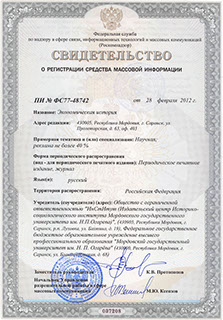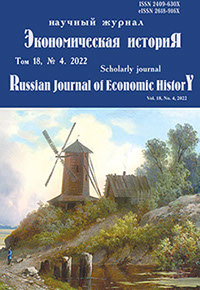Экономическая историЯ
Russian Journal of Economic History
ISSN 2409-630X (Print)
ISSN 2618-916X (Online)
Expert board:
- Scientific Council of RAS on economic history;
- Research and Educational Center «The economic history of Central Russia and the Middle Volga region» of Ogarev Mordovia State University;
- Center of Economic History of Lomonosov Moscow State University
Navigation
Certificate of registration

ISSN 2409-630X (Print), ISSN 2618-916X (Online)
DOI: 10.15507/2409-630X.059.018.202204.321-329
Tаtiana V. Shitova
Far Eastern Law Institute Ministry of Internal Affairs of the Russian Federation (Khabarovsk, Russia), e-mail: shitova.tv@mail.ru
Voluntary Donations in the Income Structure Orthodox Clergy in the Second Half of the 19th – Early20th Century (Based on the Materials of the Mordovian Region)
Abstract
Introduction. Based on the materials of the Mordovian region, one of the significant components of the income of the Orthodox clergy of the second half of the 19th – early 20th century is studied – voluntary donations. Consideration of this problem makes it possible to determine the regional aspects of the clergy’s adaptation to new socio-economic realities, which is important both theoretically and practically.
Results and Discussion. In the 1860s and 1870s, the traditional form of voluntary in-kind collection for the needs of the clergy, the ruga, was preserved in most parishes. Most of the natural fees were established by the clergy shortly after Christianization and were then broadcast as a local tradition. The basis of this collection in all villages was grain. In the 1910s, in many localities of the studied region, food collections were no longer perceived as voluntary assistance to pastors, but as extortion, which negatively affected the relationship between the flock and pastors. Among the “good deeds” of parishioners in the period under review were “mug” money – funds that church visitors donated to the needs of the clergy or for specially specified purposes. This income item, which depended both on the number of the flock and on the level of well-being of local residents, varied significantly from year to year; the size of the circle income was also influenced by the size of other public fees, yield in a specific period of time, the nature of the relationship of the flock with the clergy.
Conclusion. In the second half of the XIX – early XX century, there was a gradual replacement of natural forms of support for clerks with monetary fees. Another important trend established as a result of the reduction by many communities of traditional forms of material support for the clergy.
Keywords: clergy, church, parish, ruga, natural fees, church circle, Mordovian region.
For citation: Shitova T. V. Voluntary Donations in the Income Structure Orthodox Clergy in the Second Half of the 19th – early 20th Century (Based on the Materials of the Mordovian Region). Ekonomicheskaya istoriya = Russian Journal of Economic History. 2022; 18(4): 321–329.
(In Russ.). DOI: 10.15507/2409-630X.059.018.202203.321-329.
© Ogarev Mordovia State University. History and Sociology Institute, 2017
68, Of. 411, Bolshevistskaya St., 430005, The editorial office of the scholarly journal «Russian Journal of Economic History»
Tel.: (8342) 24-25-90; 27-07-11, Fax: (8342) 24-25-90, E-mail: jurnal-econom-hist@isi.mrsu.ru
Designed by A. Napalkov, Email: napalkov@isi.mrsu.ru

